|
In a lengthy and in-depth investigation conducted in October 2012, Animals’ Angels documented conditions at Bouvry Exports’ various locations in the US and Canada. Investigators alternated between locations throughout this investigation to document as much as possible. Due to the sheer length of time this investigation encompassed, we have merely summarized the investigation in this newsletter, but we encourage you to read the full report for detailed day to day information.
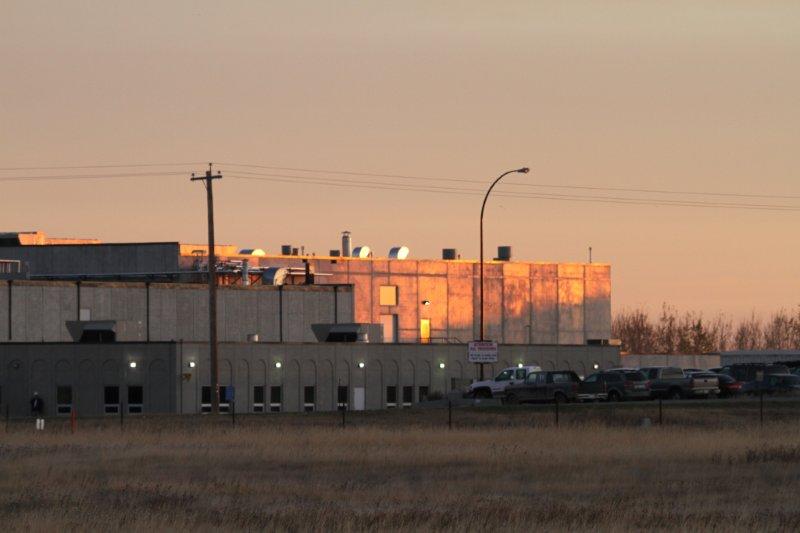 Bouvry Exports operates one of the largest horse slaughter plants in Canada approved to export horse meat to the EU. Bouvry Exports owns about 2000 acres of land near Fort Macleod, where they fatten US and Canadian horses in large feedlots. The company also leases property from the Peigan Indian Reservation near Summerview, where they are allowed to keep up to 4,500 horses. Additionally, Bouvry maintains the large “Bar S” feedlot in Shelby, Montana, which serves as a collecting station for horses bought at auctions across the US. Bouvry Exports operates one of the largest horse slaughter plants in Canada approved to export horse meat to the EU. Bouvry Exports owns about 2000 acres of land near Fort Macleod, where they fatten US and Canadian horses in large feedlots. The company also leases property from the Peigan Indian Reservation near Summerview, where they are allowed to keep up to 4,500 horses. Additionally, Bouvry maintains the large “Bar S” feedlot in Shelby, Montana, which serves as a collecting station for horses bought at auctions across the US.
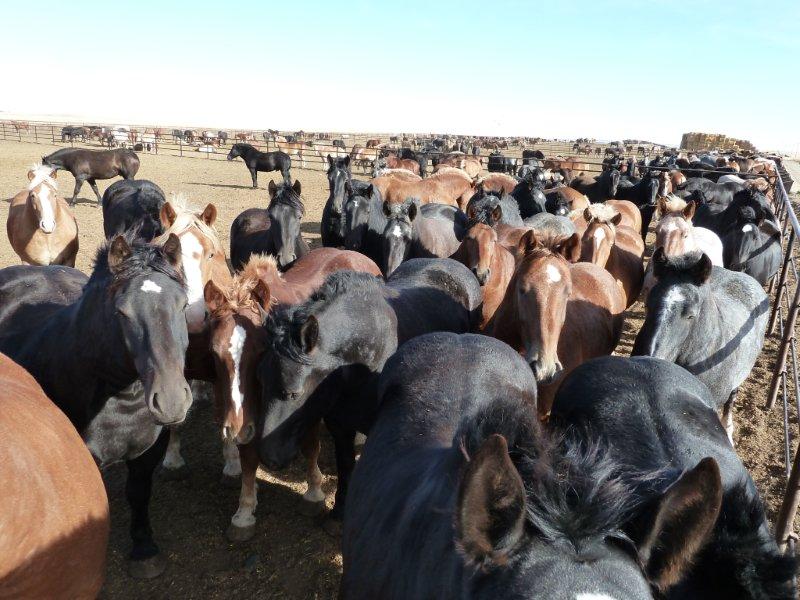 Bouvry Exports has in its possession thousands of horses on any given day which makes providing appropriate care next to impossible. Observations by Animals’ Angels during this investigation confirm this fact. Bouvry Exports has in its possession thousands of horses on any given day which makes providing appropriate care next to impossible. Observations by Animals’ Angels during this investigation confirm this fact.
We found horses that were neglected and forced to live in appalling conditions, with no shelter. Our investigators repeatedly observed the following:
- Lack of shelter in harsh weather conditions with heavy snow and temperatures as low as 11 degrees
- Horses, including foals, covered with snow and ice and left to suffer in the harsh elements
- Crowded pens
- Hooves that had not seen care and would therefore make standing and walking painful
- Obese and extremely lethargic animals, from gross overfeeding
- Fighting and distressed horses
- Emaciated horses
- Horses in great distress due to medical emergencies with no workers around to even take notice
Click here to read full length report…
Bouvry Exports Slaughter Plant
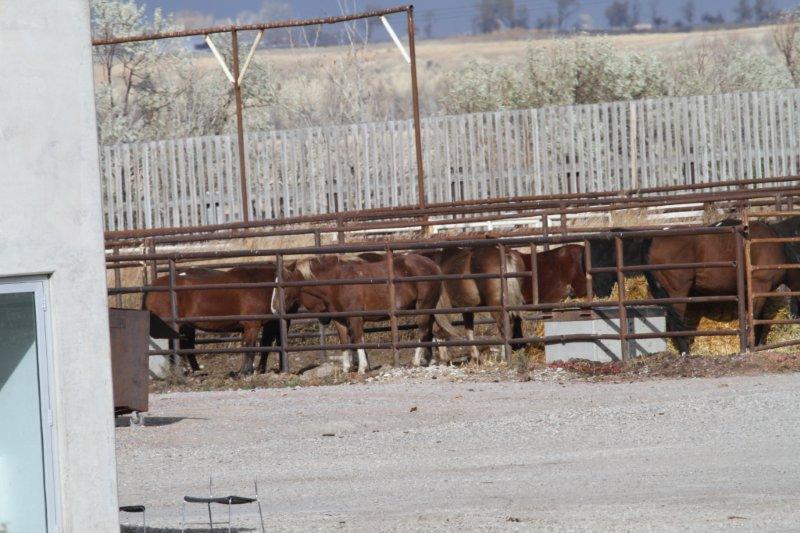 The first stop in this investigation was the Bouvry Exports slaughter plant itself. Our investigators noted that delivery trucks arrive and unload in quick succession. One truck arrived, unloaded 28 horses, and then left, all in less than 10 minutes. Fighting between the horses could be observed on the transport trailer prior to unloading. Horses kept in the paddock directly next to the slaughterhouse had visible slaughter and auction tags. Although there was water and feed available, there was no shelter. The first stop in this investigation was the Bouvry Exports slaughter plant itself. Our investigators noted that delivery trucks arrive and unload in quick succession. One truck arrived, unloaded 28 horses, and then left, all in less than 10 minutes. Fighting between the horses could be observed on the transport trailer prior to unloading. Horses kept in the paddock directly next to the slaughterhouse had visible slaughter and auction tags. Although there was water and feed available, there was no shelter.
Investigators spent several days trailing trucks from surrounding auctions and the US feedlot to the plant. Based on information gathered from trailing vehicles as well as USDA documents obtained by Animals’ Angels, it became clear that Bouvry has a large network of buyers acquiring horses for him all across the US as well as Canada, securing a steady supply for his plant.
Feedlots
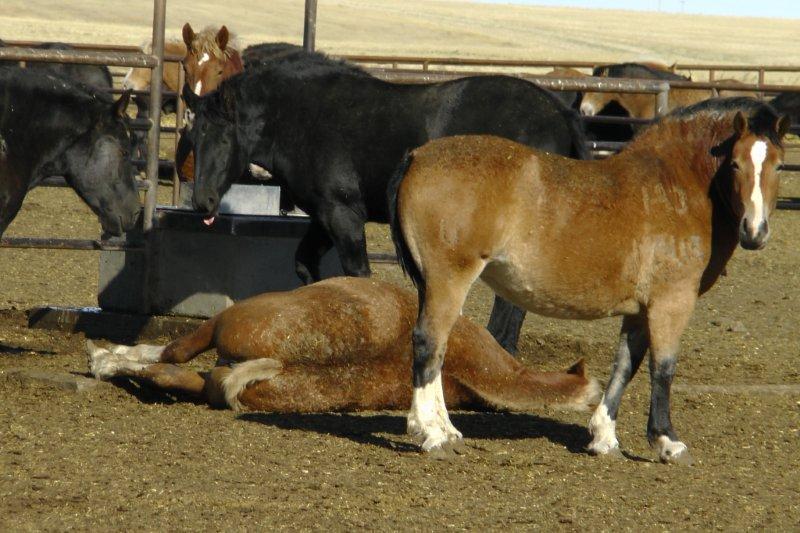 Bouvry Exports maintains numerous feedlots. The majority of horses observed were Belgium and Percheron draft horses. Several of the holding pens, especially at the Shelby feedlot in Montana and the Prime Feedlot in Granum were overcrowded. Aggressive horses were seen biting others, a behaviour some horses can develop in crowded conditions. Bouvry Exports maintains numerous feedlots. The majority of horses observed were Belgium and Percheron draft horses. Several of the holding pens, especially at the Shelby feedlot in Montana and the Prime Feedlot in Granum were overcrowded. Aggressive horses were seen biting others, a behaviour some horses can develop in crowded conditions.
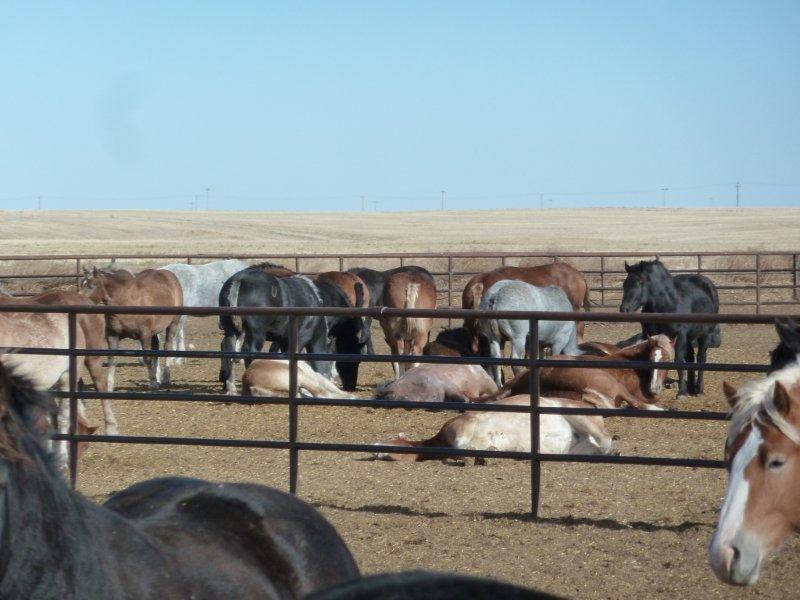 Most of the horses were tremendously overweight, having been fattened prior to slaughter. They were eating or lying on the ground lethargically. They didn’t even lift their heads when other horses walked by or were fighting next to them, which is very unusual behaviour. Only their breathing showed they were still alive. Most of the horses were tremendously overweight, having been fattened prior to slaughter. They were eating or lying on the ground lethargically. They didn’t even lift their heads when other horses walked by or were fighting next to them, which is very unusual behaviour. Only their breathing showed they were still alive.
As our investigation progressed, the weather took a severe turn. It snowed heavily with high winds and the temperature dropped to 11 degrees. There was absolutely no shelter protecting the horses from the snow, wind or freezing temperatures. They were left to endure the harsh elements.
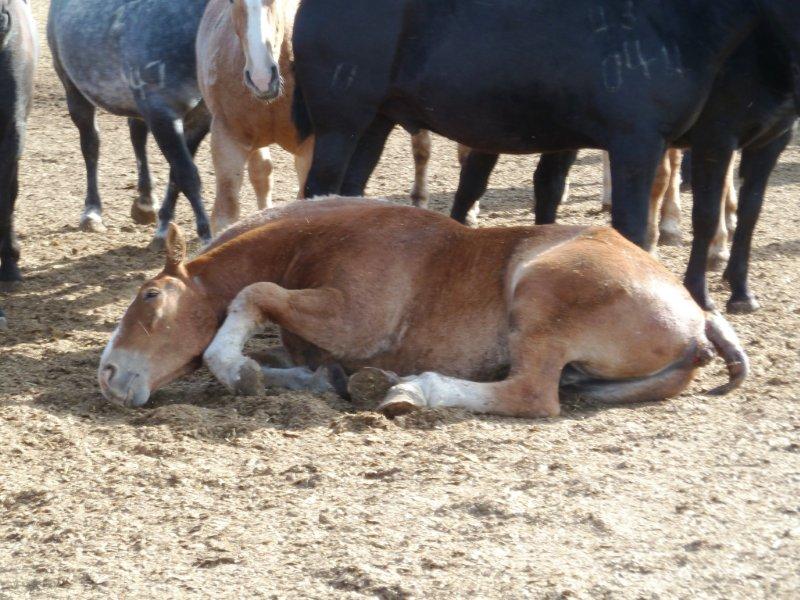 A good many of the horses had neglected hooves which evidenced a complete lack of farrier care. One horse could be seen with an open wound just above the hoof. Another horse was found down and apparently sick. Blood was visible around his anus. He was able to lift his head, but did not have the energy to stand. A good many of the horses had neglected hooves which evidenced a complete lack of farrier care. One horse could be seen with an open wound just above the hoof. Another horse was found down and apparently sick. Blood was visible around his anus. He was able to lift his head, but did not have the energy to stand.
Given the number of horses contained in the feedlots, it is likely that injuries & sicknesses often go unnoticed and untreated. It would be extremely difficult if not impossible for anyone to adequately maintain proper care for so many horses.
One incident in particular needs to be highlighted as it raises grave concerns for the whole:
 A mare had tried to give birth, however, the foal had come out head first instead of legs first and it died in mid-birth with only the head emerging from the mare. When investigators found her, she was already very weak and unable to rise. The foal was still lodged inside of her and a steady stream of blood was dripping from her teats. The surrounding horses nudged at her and the head of the dead foal. At this heart breaking scene, the investigators made the decision to call the local SPCA to get much needed help for the suffering mare. A mare had tried to give birth, however, the foal had come out head first instead of legs first and it died in mid-birth with only the head emerging from the mare. When investigators found her, she was already very weak and unable to rise. The foal was still lodged inside of her and a steady stream of blood was dripping from her teats. The surrounding horses nudged at her and the head of the dead foal. At this heart breaking scene, the investigators made the decision to call the local SPCA to get much needed help for the suffering mare.
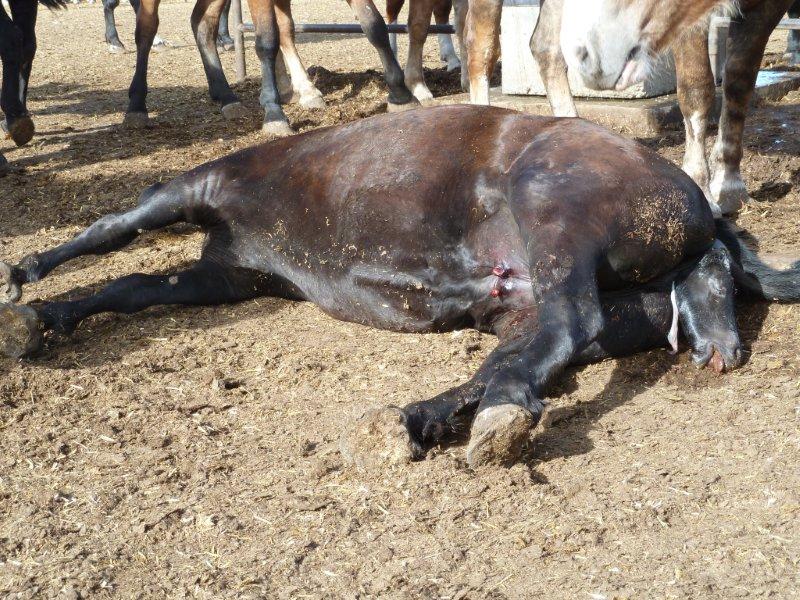 It took over an hour for the SPCA officer to arrive and during this time the mare continued to endure what had to be pure agony. It was heart wrenching even for seasoned investigators to witness such a horrendous sight. However, much to our investigator’s disbelief, the presence of the SPCA officer brought no relief to the mare’s suffering as apparently there were no plans to euthanize her nor was a vet brought in to attend her. The SPCA officer only briefly looked at her, spoke to some workers and then left the scene. It took over an hour for the SPCA officer to arrive and during this time the mare continued to endure what had to be pure agony. It was heart wrenching even for seasoned investigators to witness such a horrendous sight. However, much to our investigator’s disbelief, the presence of the SPCA officer brought no relief to the mare’s suffering as apparently there were no plans to euthanize her nor was a vet brought in to attend her. The SPCA officer only briefly looked at her, spoke to some workers and then left the scene.
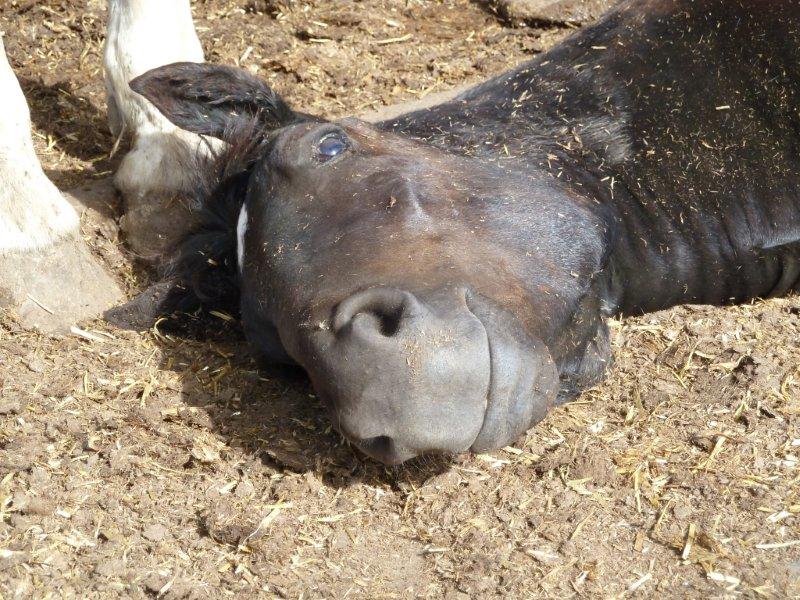 Indeed, our investigators had to interrupt the friendly, laughing conversation between the SPCA officer and a Bouvry worker to inquire as to the mare’s condition. To see such a conciliatory manner between the Bouvry workers and the SPCA officer is disconcerting to say the least. It was obvious that the SPCA officer failed in his duty that day as he should have remained with the mare to ensure that she would receive humane and appropriate treatment. Leaving her in the care of Bouvry’s workers and without a veterinarian is not responsible. Indeed, our investigators had to interrupt the friendly, laughing conversation between the SPCA officer and a Bouvry worker to inquire as to the mare’s condition. To see such a conciliatory manner between the Bouvry workers and the SPCA officer is disconcerting to say the least. It was obvious that the SPCA officer failed in his duty that day as he should have remained with the mare to ensure that she would receive humane and appropriate treatment. Leaving her in the care of Bouvry’s workers and without a veterinarian is not responsible.
Pastures with Mares and Foals
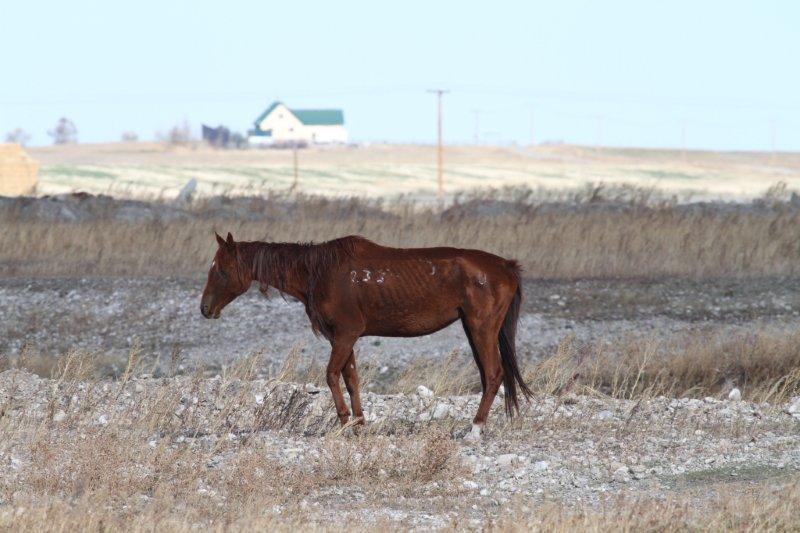 In addition to the feedlots, Bouvry Exports maintains vast pastures with mares and foals. Although there was shelter at one pasture, it wasn’t large enough for all of the horses present. Dominant mares will fight aggressively for shelter and keep weaker mares and especially foals out. The foals observed were very young and many were lying down. However, one foal did not move even when approached, with only his breathing to indicate he was alive at all. Several of the mares were thin and their ribs were showing. One extremely emaciated mare was found, however, she disappeared the following day. In addition to the feedlots, Bouvry Exports maintains vast pastures with mares and foals. Although there was shelter at one pasture, it wasn’t large enough for all of the horses present. Dominant mares will fight aggressively for shelter and keep weaker mares and especially foals out. The foals observed were very young and many were lying down. However, one foal did not move even when approached, with only his breathing to indicate he was alive at all. Several of the mares were thin and their ribs were showing. One extremely emaciated mare was found, however, she disappeared the following day.
 When the temperatures dropped and heavy snow began to fall, the mares gathered around the foals in an attempt to protect them from the heavy snow and ice build-up that was obvious on all of the horses. The foals were a sad sight as their coats were caked with snow and ice. The young foals were clearly suffering greatly from the extreme temperatures and weather. To add to the cruelty, there was a large empty barn just outside the holding area but as it was fenced off, the horses could not reach it. Of grave concern is the fact that temperatures in this area can and do drop to as low as -15 degrees making it questionable if all of these foals will even survive the winter. Sadly, without adequate shelter, many will likely succumb to such harsh temperatures. When the temperatures dropped and heavy snow began to fall, the mares gathered around the foals in an attempt to protect them from the heavy snow and ice build-up that was obvious on all of the horses. The foals were a sad sight as their coats were caked with snow and ice. The young foals were clearly suffering greatly from the extreme temperatures and weather. To add to the cruelty, there was a large empty barn just outside the holding area but as it was fenced off, the horses could not reach it. Of grave concern is the fact that temperatures in this area can and do drop to as low as -15 degrees making it questionable if all of these foals will even survive the winter. Sadly, without adequate shelter, many will likely succumb to such harsh temperatures.
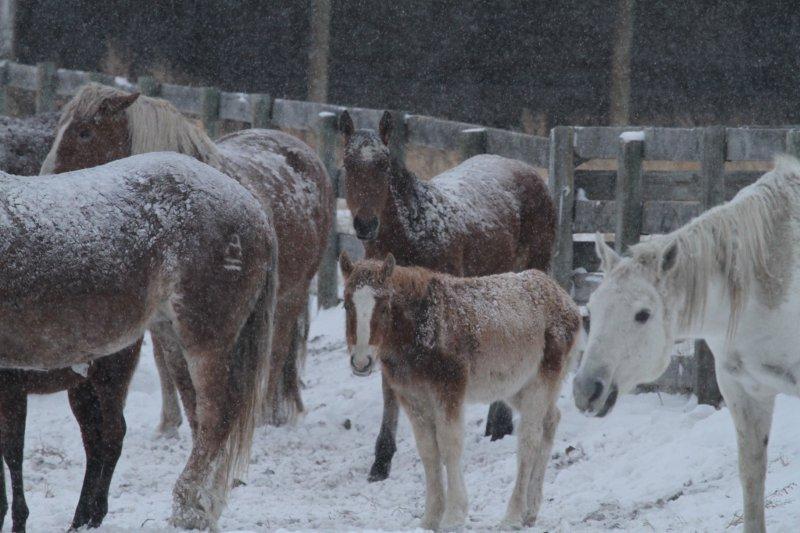 Bouvry Exports is a vast slaughter empire built squarely on the backs of horses. The conditions observed by Animals’ Angels investigators over the course of this intensive investigation show a consistent lack of even the most basic care. Of equal concern is the witnessed attitude of local SPCA staff towards Bouvry. Bouvry Exports is a vast slaughter empire built squarely on the backs of horses. The conditions observed by Animals’ Angels investigators over the course of this intensive investigation show a consistent lack of even the most basic care. Of equal concern is the witnessed attitude of local SPCA staff towards Bouvry.
Animals’ Angels will use the evidence gathered during this investigation for our 2013 consumer awareness campaign in Europe. We will keep you updated on the progress. Please also continue to contact your representatives and let them know how you feel about the plight of our horses. There is strength in numbers, so encourage your family and friends to do the same.
more wild horse info at www.windwildhorse.com
Click here to read full length report…
more wild horse info at www.windwildhorse.com
|

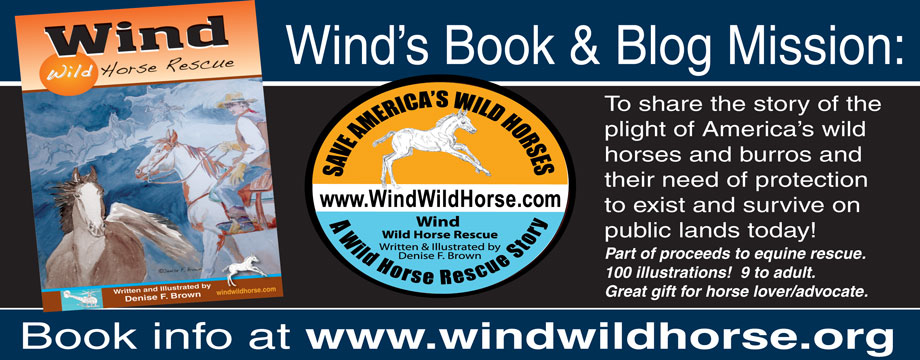
 Bouvry Exports operates one of the largest horse slaughter plants in Canada
Bouvry Exports operates one of the largest horse slaughter plants in Canada  Bouvry Exports has in its possession thousands of horses on any given day which makes providing appropriate care next to impossible. Observations by Animals’ Angels during this investigation confirm this fact.
Bouvry Exports has in its possession thousands of horses on any given day which makes providing appropriate care next to impossible. Observations by Animals’ Angels during this investigation confirm this fact. The first stop in this investigation was the Bouvry Exports slaughter plant itself. Our investigators noted that delivery trucks arrive and unload in quick succession. One truck arrived, unloaded 28 horses, and then left, all in less than 10 minutes. Fighting between the horses could be observed on the transport trailer prior to unloading. Horses kept in the paddock directly next to the slaughterhouse had visible slaughter and auction tags. Although there was water and feed available, there was no shelter.
The first stop in this investigation was the Bouvry Exports slaughter plant itself. Our investigators noted that delivery trucks arrive and unload in quick succession. One truck arrived, unloaded 28 horses, and then left, all in less than 10 minutes. Fighting between the horses could be observed on the transport trailer prior to unloading. Horses kept in the paddock directly next to the slaughterhouse had visible slaughter and auction tags. Although there was water and feed available, there was no shelter. Bouvry Exports maintains numerous feedlots. The majority of horses observed were Belgium and Percheron draft horses. Several of the holding pens, especially at the Shelby feedlot in Montana and the Prime Feedlot in Granum were overcrowded. Aggressive horses were seen biting others, a behaviour some horses can develop in crowded conditions.
Bouvry Exports maintains numerous feedlots. The majority of horses observed were Belgium and Percheron draft horses. Several of the holding pens, especially at the Shelby feedlot in Montana and the Prime Feedlot in Granum were overcrowded. Aggressive horses were seen biting others, a behaviour some horses can develop in crowded conditions. Most of the horses were tremendously overweight, having been fattened prior to slaughter. They were eating or lying on the ground lethargically. They didn’t even lift their heads when other horses walked by or were fighting next to them, which is very unusual behaviour. Only their breathing showed they were still alive.
Most of the horses were tremendously overweight, having been fattened prior to slaughter. They were eating or lying on the ground lethargically. They didn’t even lift their heads when other horses walked by or were fighting next to them, which is very unusual behaviour. Only their breathing showed they were still alive. A good many of the horses had neglected hooves which evidenced a complete lack of farrier care. One horse could be seen with an open wound just above the hoof. Another horse was found down and apparently sick. Blood was visible around his anus. He was able to lift his head, but did not have the energy to stand.
A good many of the horses had neglected hooves which evidenced a complete lack of farrier care. One horse could be seen with an open wound just above the hoof. Another horse was found down and apparently sick. Blood was visible around his anus. He was able to lift his head, but did not have the energy to stand. A mare had tried to give birth, however, the foal had come out head first instead of legs first and it died in mid-birth with only the head emerging from the mare. When investigators found her, she was already very weak and unable to rise. The foal was still lodged inside of her and a steady stream of blood was dripping from her teats. The surrounding horses nudged at her and the head of the dead foal. At this heart breaking scene, the investigators made the decision to call the local SPCA to get much needed help for the suffering mare.
A mare had tried to give birth, however, the foal had come out head first instead of legs first and it died in mid-birth with only the head emerging from the mare. When investigators found her, she was already very weak and unable to rise. The foal was still lodged inside of her and a steady stream of blood was dripping from her teats. The surrounding horses nudged at her and the head of the dead foal. At this heart breaking scene, the investigators made the decision to call the local SPCA to get much needed help for the suffering mare. It took over an hour for the SPCA officer to arrive and during this time the mare continued to endure what had to be pure agony. It was heart wrenching even for seasoned investigators to witness such a horrendous sight. However, much to our investigator’s disbelief, the presence of the SPCA officer brought no relief to the mare’s suffering as apparently there were no plans to euthanize her nor was a vet brought in to attend her. The SPCA officer only briefly looked at her, spoke to some workers and then left the scene.
It took over an hour for the SPCA officer to arrive and during this time the mare continued to endure what had to be pure agony. It was heart wrenching even for seasoned investigators to witness such a horrendous sight. However, much to our investigator’s disbelief, the presence of the SPCA officer brought no relief to the mare’s suffering as apparently there were no plans to euthanize her nor was a vet brought in to attend her. The SPCA officer only briefly looked at her, spoke to some workers and then left the scene. Indeed, our investigators had to interrupt the friendly, laughing conversation between the SPCA officer and a Bouvry worker to inquire as to the mare’s condition. To see such a conciliatory manner between the Bouvry workers and the SPCA officer is disconcerting to say the least. It was obvious that the SPCA officer failed in his duty that day as he should have remained with the mare to ensure that she would receive humane and appropriate treatment. Leaving her in the care of Bouvry’s workers and without a veterinarian is not responsible.
Indeed, our investigators had to interrupt the friendly, laughing conversation between the SPCA officer and a Bouvry worker to inquire as to the mare’s condition. To see such a conciliatory manner between the Bouvry workers and the SPCA officer is disconcerting to say the least. It was obvious that the SPCA officer failed in his duty that day as he should have remained with the mare to ensure that she would receive humane and appropriate treatment. Leaving her in the care of Bouvry’s workers and without a veterinarian is not responsible. In addition to the feedlots, Bouvry Exports maintains vast pastures with mares and foals. Although there was shelter at one pasture, it wasn’t large enough for all of the horses present. Dominant mares will fight aggressively for shelter and keep weaker mares and especially foals out. The foals observed were very young and many were lying down. However, one foal did not move even when approached, with only his breathing to indicate he was alive at all. Several of the mares were thin and their ribs were showing. One extremely emaciated mare was found, however, she disappeared the following day.
In addition to the feedlots, Bouvry Exports maintains vast pastures with mares and foals. Although there was shelter at one pasture, it wasn’t large enough for all of the horses present. Dominant mares will fight aggressively for shelter and keep weaker mares and especially foals out. The foals observed were very young and many were lying down. However, one foal did not move even when approached, with only his breathing to indicate he was alive at all. Several of the mares were thin and their ribs were showing. One extremely emaciated mare was found, however, she disappeared the following day. When the temperatures dropped and heavy snow began to fall, the mares gathered around the foals in an attempt to protect them from the heavy snow and ice build-up that was obvious on all of the horses. The foals were a sad sight as their coats were caked with snow and ice. The young foals were clearly suffering greatly from the extreme temperatures and weather. To add to the cruelty, there was a large empty barn just outside the holding area but as it was fenced off, the horses could not reach it. Of grave concern is the fact that temperatures in this area can and do drop to as low as -15 degrees making it questionable if all of these foals will even survive the winter. Sadly, without adequate shelter, many will likely succumb to such harsh temperatures.
When the temperatures dropped and heavy snow began to fall, the mares gathered around the foals in an attempt to protect them from the heavy snow and ice build-up that was obvious on all of the horses. The foals were a sad sight as their coats were caked with snow and ice. The young foals were clearly suffering greatly from the extreme temperatures and weather. To add to the cruelty, there was a large empty barn just outside the holding area but as it was fenced off, the horses could not reach it. Of grave concern is the fact that temperatures in this area can and do drop to as low as -15 degrees making it questionable if all of these foals will even survive the winter. Sadly, without adequate shelter, many will likely succumb to such harsh temperatures. Bouvry Exports is a vast slaughter empire built squarely on the backs of horses. The conditions observed by Animals’ Angels investigators over the course of this intensive investigation show a consistent lack of even the most basic care. Of equal concern is the witnessed attitude of local SPCA staff towards Bouvry.
Bouvry Exports is a vast slaughter empire built squarely on the backs of horses. The conditions observed by Animals’ Angels investigators over the course of this intensive investigation show a consistent lack of even the most basic care. Of equal concern is the witnessed attitude of local SPCA staff towards Bouvry.